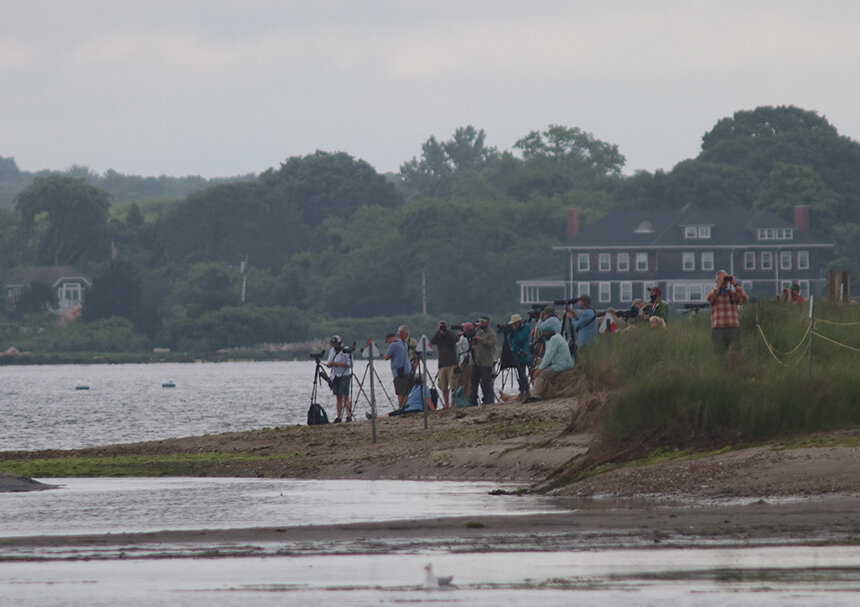‘Mega-Rarity’ Shorebird Discovered in Napatree Point
July 1, 2020
The mile-long pilgrimage out to the tip of Napatree Point in Westerly, the southwestern-most point in the Ocean State, is a common hike for birdwatchers in spring and late summer, as it’s one of the best locations to find migrating shorebirds. But during the last few days of June, hundreds more birders than usual made the trek after an extremely rare bird — a “mega-rarity” in birdwatching lingo — was discovered there.
A Terek sandpiper, distinctive for its long, upturned beak and yellow-orange legs, was observed Sunday morning, June 28, by Jan St. Jean, a Charlestown resident and avid birder. It is the first documented sighting of the species in Rhode Island and is considered by some to be the rarest bird to show up in the Ocean State in decades.
“I first saw it behind a mound of seaweed, and it bobbed up and down like a spotted sandpiper,” she said, referring to a commonly seen species at Napatree. “But then I saw that bill and thought, ‘Oh my god, this is something really good.’ But I didn’t have my scope to get a better look.”
She texted several birding friends, one of whom, Carlos Pedro, was birding in nearby Charlestown and happened to have a field guide to European birds with him.
“I described it to him, and right away he said ‘Terek,’” St. Jean said. “Everything added up that that’s what it was.”
Terek sandpipers breed in Finland and across much of northern Russia and winter on the coast of East Africa, Australia, and South Asia. It is named for the Terek River, which flows into the Caspian Sea, where it was first observed.
According to Rachel Farrell, a member of the Rhode Island Avian Records Committee, the Terek sandpiper has been reported on the East Coast just three other times, including a Massachusetts appearance in 1990. It’s a rare but regular visitor to the western Aleutian Islands of Alaska and has been observed along the California coast several times.
“I would think this is the rarest bird seen here in at least 20 years,” said Farrell, “and maybe since a spotted redshank was reported in the 1940s or ’50s. A wood sandpiper seen in Jamestown [in 2012] is probably a close second.”
How the bird got here is anyone’s guess.
“No one will ever know,” Farrell said. “It could have flown straight across the Atlantic. That’s probably the most likely scenario. I can’t see it coming from the Pacific and flying across the country. Maybe it came from its breeding grounds over to Greenland and then to the Canadian Maritimes and down to here.”
St. Jean said that, when she finally realized how rare the bird was in North America, she started shaking.
“My first concern was that I wanted someone else to see it,” she said. “I didn’t want to be the only one to see it and then have it fly away and not have any documentation.”

By Sunday afternoon, the Rhode Island birding community had been alerted to the bird and dozens of people converged on Napatree Point. Many missed seeing it when the bird flew off in the direction of Sandy Point Island, a 35-acre island in Little Narragansett Bay that was formerly part of Napatree Point.
The bird was relocated early Monday morning, much to the delight of Rhode Island birders, and by Tuesday morning, more than 100 birders from as far away as New Jersey and Ohio were making the long walk out to Napatree Point to see it. At times, the bird wasn’t particularly cooperative, flying to Sandy Point again or remaining hidden in the abundant mounds of seaweed on the western edge of Napatree.
The discovery of the Terek sandpiper was the third time St. Jean had found a bird never before recorded in Rhode Island. She located the state’s first white-faced ibis, a common bird on the Gulf Coast of Texas and elsewhere in the West, at Marsh Meadows in Jamestown in 1998. She also discovered the state’s first record of a Ross’s goose in 2001 at Trustom Pond National Wildlife Refuge in South Kingstown.
“I’m out there looking for birds every day, if I can,” she said. “I know what to look for and when, and I enjoy it. It’s fun.”
The only downside to her discovery of the Terek sandpiper? After waiting to point out the bird to Pedro and other arriving birders, St. Jean was issued a $75 parking ticket for overextending her stay.
Rhode Island resident and author Todd McLeish runs a wildlife blog.




That’s incredible! What an expert birder & a great find.